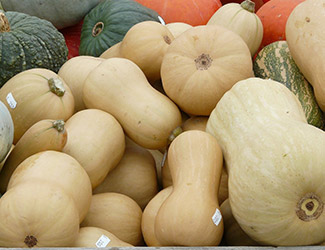Adding Butternut Squash to Your Family Meals
Nutrition Notes and Family-friendly Recipes from Clinical Dietitian Pamela Patt
With more time at home during the pandemic, many families are thinking about how to cook and eat healthier. Butternut squash is one of the many colorful winter squashes available in stores when the temperatures turn cooler. Pamela Patt, MS, RDN, CSP, LDN, CNSC, clinical dietitian and director of nutrition services at Shriners Hospitals for Children — Chicago, says butternut squash is a great source of nutrients that help the body function. And she offers three family-friendly recipes to help even picky eaters try butternut squash.
Nutritious Benefits of Butternut Squash
“It is a great source of Vitamin A, C and E. All of these help your body maintain a healthy immune response,” Patt said. Here is more from Patt on how those three vitamins in squash can help in your body.
- Vitamin A helps with the body’s natural defenses, including mucus membranes, that help prevent things from entering the body. It’s also involved in the production and function of white blood cells, which help capture and clear bacteria and other pathogens from your bloodstream.
- Vitamin C supports immunity by protecting the integrity of cells and affecting the production and function of white blood cells. Vitamin C is a powerful antioxidant and helps fight free radicals in the body.
- Vitamin E, an antioxidant present in all cellular membranes, is an important nutrient for helping the immune system function at its best.
Patt adds that butternut squash is also high in water and fiber content, helping you stay hydrated and promoting healthy digestive function.
Three Family-friendly Recipes for Butternut Squash
Parents may know the health benefits of squash but may need some help getting their family to eat it. Patt offers three family-friendly methods of preparing butternut squash that may help it to become a regular part of your menu.
Make a breakfast hash. Coat a nonstick skillet with 1 tablespoon olive oil. Fry cubed butternut squash, diced ham, and diced onions over medium-high heat until squash is tender. Season with salt and pepper and serve with a fried egg on top.
Everybody loves muffins. Substitute 1 cup pureed butternut squash for oil in your favorite corn muffin mix. Add ½ teaspoon nutmeg. Fill muffin cups ½ full and bake at 350 F until a toothpick inserted in the center comes out clean. Great for breakfast or a snack.
Do you like roasted vegetables? Try cinnamon roasted butternut squash. Patt suggests a recipe from wellplated.com. It includes cubes of butternut squash tossed with maple syrup, cinnamon and rosemary, all roasted to caramelized perfection.
Pamela Patt is the director of nutrition services and clinical dietitian at Shriners Hospitals for Children — Chicago. She is passionate about health and wellness for all children with disabilities and their families. She and her team provide nutrition screening, assessment, counseling and documentation for all hospitalized patients, along with outpatient nutrition counseling. Learn more about her.

Keep In Touch
Join our mailing list to stay up to date on everything that's happening at Shriners Children's.
